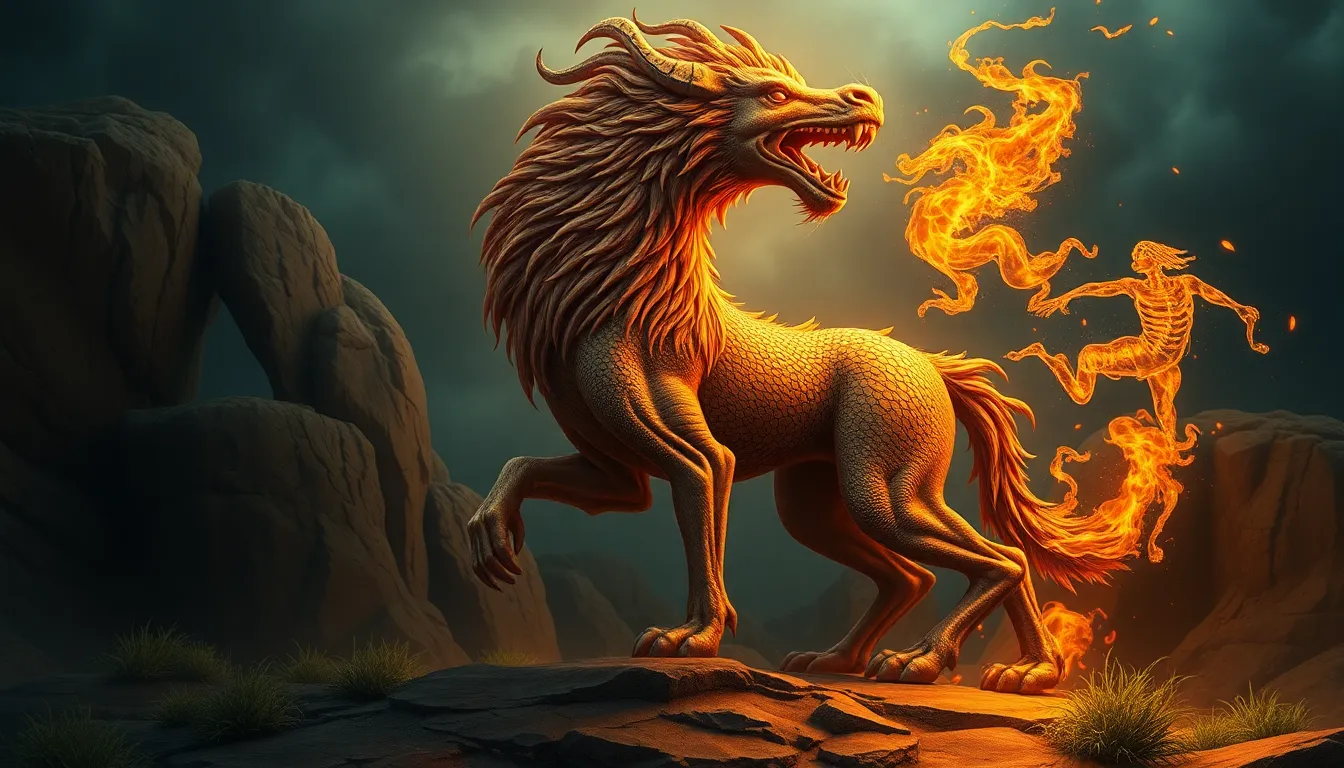The Role of the Chimera in Greek Folklore and Oral Traditions
I. Introduction
The Chimera is one of the most fascinating creatures in Greek mythology, often depicted as a monstrous hybrid with the body of a lion, the head of a goat protruding from its back, and a serpent for a tail. This creature symbolizes the chaotic and unpredictable nature of existence, embodying the fears and challenges faced by humanity.
Greek folklore and oral traditions have played a significant role in shaping the cultural narrative surrounding such mythical beings as the Chimera. Through storytelling, these legends have been passed down from generation to generation, enriching the cultural tapestry of ancient Greece.
The Chimera stands as a cultural symbol, representing the duality of beauty and monstrosity, and reflecting the philosophical inquiries of human existence. It serves as a reminder of the complexities of life, making it an enduring figure in Greek mythology.
II. Origins of the Chimera in Greek Mythology
The origins of the Chimera can be traced back to ancient texts, including Hesiod’s “Theogony” and Homer’s “Iliad.” These works provide some of the earliest references to this fearsome creature, highlighting its significance in the mythological canon.
Physically, the Chimera is described as a terrifying beast with:
- The body of a lion, representing strength and power.
- A goat’s head on its back, symbolizing stubbornness and aggression.
- A serpent or dragon for a tail, adding an element of danger and venom.
In terms of lineage, the Chimera is often considered the offspring of Typhon and Echidna, two of the most notorious monsters in Greek mythology. Its siblings include other formidable creatures such as the Nemean Lion and the Hydra, establishing the Chimera’s place within a lineage of chaos and destruction.
III. The Chimera’s Symbolism
The Chimera embodies various symbolic meanings that resonate with human experiences and fears:
- Representation of chaos and danger: The Chimera’s hybrid form is a direct representation of chaos, as it combines elements from different animals, leading to a creature that defies natural order.
- Duality of nature: The Chimera exemplifies the duality of beauty and monstrosity. While it is a creature of horror, it captivates the imagination, reflecting the complexities of life.
- Metaphor for human fears: The Chimera serves as a metaphor for the challenges and fears that individuals face, whether they be personal struggles or societal issues.
IV. The Chimera in Heroic Mythology
One of the most famous encounters involving the Chimera is that of the hero Bellerophon, who was tasked with slaying this fearsome beast. The story of Bellerophon showcases the Chimera as a formidable adversary and highlights its role in heroic mythology.
The Chimera’s significance in heroic myths can be summarized as follows:
- Encounters with famous heroes: Bellerophon, riding the winged horse Pegasus, confronts the Chimera, demonstrating the theme of the hero overcoming monstrous challenges.
- Formidable adversary: The Chimera is not just a simple monster; it represents a significant hurdle in the hero’s journey, testing their courage and ingenuity.
- Role in quests: The defeat of the Chimera is crucial for the hero’s development, marking a transition in their journey from novice to champion.
V. Oral Traditions and Storytelling
The stories of the Chimera have been transmitted through oral traditions, which were vital for preserving Greek mythology. These narratives were shared among communities, often evolving with each retelling.
Key aspects of oral traditions include:
- Transmission through generations: Oral storytelling allowed for the myths of the Chimera to be passed down, ensuring that the creature remained a vital part of cultural heritage.
- Variations in regional folklore: Different regions of Greece may have their own unique versions of the Chimera’s story, reflecting local beliefs and practices.
- Preserving legacy: Oral traditions have played a crucial role in keeping the legend of the Chimera alive, allowing it to adapt and remain relevant in the cultural psyche.
VI. The Chimera in Art and Literature
Throughout history, the Chimera has been depicted in various forms of art and literature, showcasing its enduring influence:
- Ancient Greek pottery and sculpture: The Chimera has been portrayed in numerous artifacts, often emphasizing its fearsome features and chaotic nature.
- Reinterpretations in classical literature: Writers like Apollonius of Rhodes have included the Chimera in their works, exploring its significance in the context of heroism and myth.
- Contemporary art and media: The Chimera continues to inspire modern artists and storytellers, reflecting ongoing themes of identity and transformation.
VII. Modern Interpretations and Cultural Impact
In contemporary times, the Chimera has found new life in literature and popular culture:
- Modern literature: The Chimera appears in various modern novels and stories, often as a symbol of inner conflict and the struggle for identity.
- Symbolic uses: The concept of the Chimera is frequently invoked in discussions about hybridity, identity, and the challenges of modern life.
- Modern Greek culture: The Chimera remains a significant figure in modern Greek heritage, serving as a reminder of the rich mythological past.
VIII. Conclusion
The Chimera holds immense significance in Greek folklore, serving as a representation of chaos, fear, and the duality of existence. Its stories have been preserved through oral traditions, art, and literature, allowing it to maintain a prominent place in cultural identity.
Reflecting on the enduring legacy of the Chimera, it becomes evident that myths play a crucial role in understanding human experiences and cultural values. The Chimera, with its complex symbolism and heroic narratives, continues to resonate, reminding us of the importance of myth in shaping our understanding of the world.
In conclusion, the Chimera is not just a monster from antiquity; it is a multifaceted symbol that invites us to explore the complexities of existence, making it an integral part of Greek mythology and cultural heritage.




